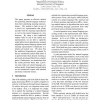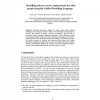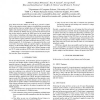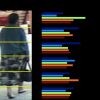873 search results - page 12 / 175 » Language model adaptation using Random Forests |
EMNLP
2009
13 years 5 months ago
2009
This paper presents an effective method for generating natural language sentences from their underlying meaning representations. The method is built on top of a hybrid tree repres...
CAISE
2003
Springer
14 years 22 days ago
2003
Springer
Providing technology support for older people offers distinct challenges for social and IT systems delivery. The definition and integration of services, the diversity of supply, va...
ICASSP
2011
IEEE
12 years 11 months ago
2011
IEEE
Deep Belief Networks (DBNs) are multi-layer generative models. They can be trained to model windows of coefficients extracted from speech and they discover multiple layers of fea...
BMCBI
2010
13 years 7 months ago
2010
Background: Data generated using `omics' technologies are characterized by high dimensionality, where the number of features measured per subject vastly exceeds the number of...
189
click to vote
Publication
State-of-the-art person re-identi
cation methods seek robust person matching through combining various feature types. Often, these features are implicitly assigned with a single ve...




